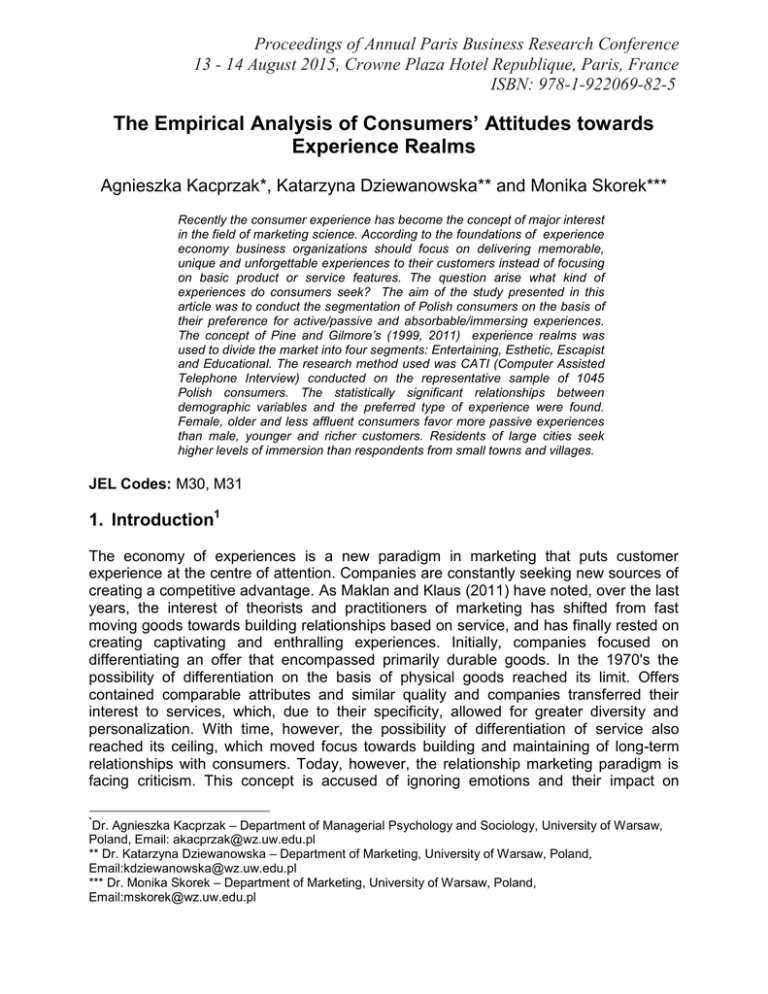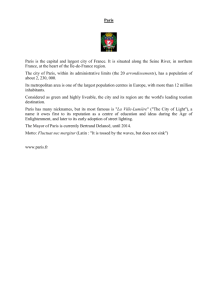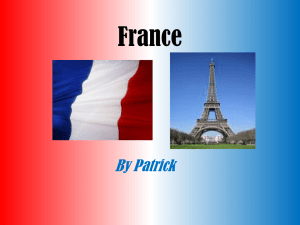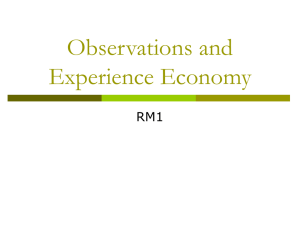Proceedings of Annual Paris Business Research Conference
advertisement

Proceedings of Annual Paris Business Research Conference 13 - 14 August 2015, Crowne Plaza Hotel Republique, Paris, France ISBN: 978-1-922069-82-5 The Empirical Analysis of Consumers’ Attitudes towards Experience Realms Agnieszka Kacprzak*, Katarzyna Dziewanowska** and Monika Skorek*** Recently the consumer experience has become the concept of major interest in the field of marketing science. According to the foundations of experience economy business organizations should focus on delivering memorable, unique and unforgettable experiences to their customers instead of focusing on basic product or service features. The question arise what kind of experiences do consumers seek? The aim of the study presented in this article was to conduct the segmentation of Polish consumers on the basis of their preference for active/passive and absorbable/immersing experiences. The concept of Pine and Gilmore’s (1999, 2011) experience realms was used to divide the market into four segments: Entertaining, Esthetic, Escapist and Educational. The research method used was CATI (Computer Assisted Telephone Interview) conducted on the representative sample of 1045 Polish consumers. The statistically significant relationships between demographic variables and the preferred type of experience were found. Female, older and less affluent consumers favor more passive experiences than male, younger and richer customers. Residents of large cities seek higher levels of immersion than respondents from small towns and villages. JEL Codes: M30, M31 1. Introduction1 The economy of experiences is a new paradigm in marketing that puts customer experience at the centre of attention. Companies are constantly seeking new sources of creating a competitive advantage. As Maklan and Klaus (2011) have noted, over the last years, the interest of theorists and practitioners of marketing has shifted from fast moving goods towards building relationships based on service, and has finally rested on creating captivating and enthralling experiences. Initially, companies focused on differentiating an offer that encompassed primarily durable goods. In the 1970's the possibility of differentiation on the basis of physical goods reached its limit. Offers contained comparable attributes and similar quality and companies transferred their interest to services, which, due to their specificity, allowed for greater diversity and personalization. With time, however, the possibility of differentiation of service also reached its ceiling, which moved focus towards building and maintaining of long-term relationships with consumers. Today, however, the relationship marketing paradigm is facing criticism. This concept is accused of ignoring emotions and their impact on * Dr. Agnieszka Kacprzak – Department of Managerial Psychology and Sociology, University of Warsaw, Poland, Email: akacprzak@wz.uw.edu.pl ** Dr. Katarzyna Dziewanowska – Department of Marketing, University of Warsaw, Poland, Email:kdziewanowska@wz.uw.edu.pl *** Dr. Monika Skorek – Department of Marketing, University of Warsaw, Poland, Email:mskorek@wz.uw.edu.pl Proceedings of Annual Paris Business Research Conference 13 - 14 August 2015, Crowne Plaza Hotel Republique, Paris, France ISBN: 978-1-922069-82-5 consumer behaviour and on the stability of relationships. The answer seems to be marketing based on the experience of the consumer and the value it generates (Palmer, 2010, Christopher et al., 1991). This article focuses on the search for answers to the questions of what experiences consumers are looking for and what influence do their demographic characteristics have on the type searched experiences. The starting point for our analysis is Pine and Gilmore's (1999) experience realms concept. 2. Literature review 2.1. Classifications of consumer experience In the literature of the subject, many different classifications of experiences have been proposed. The first of them were quite simple, as the distinction between ordinary and extraordinary experience (Abrahams, 1986), or the division into fantasies, feelings and fun (Holbrook and Hirschman, 1982). Later there were more complex, multidimensional classifications, such as, for example, O'Sullivan and Sprangler's (1998) sixteen combinations of experience designated around the axis of reality and virtuality, originality and mediocrity, mass production and customization and the level of intensity of the interaction with other people. On the other hand, Schmitt (1999) is the author of a five element set of strategic experience modules that include sensual, emotional, intellectual, behavioural and relational sensations. This proposal was later extended by Gentile, Spiller and Noci (2007) to six components of experience: sensory (sensual sensations), emotional (mood, emotions and feelings), cognitive (conscious mental processes), pragmatic (physical function and usability) concerning lifestyle (values and personal beliefs) and relational (belonging to a community and social identity confirmation). For the purpose of this study the classification of experiences proposed by Pine and Gilmore (1999, 2011) was selected, in which they divide them into four possible experience realms. 2.2. Concept of experience realms (4E) This theory divides the experiences that are possible to be provided to consumers into four types according to the level of activity required of the consumer and the level of immersion in the offered experience. The degree of activity speaks of to what extent a consumer in a given situation is expected to remain only a passive observer, and to what extent he is to become an active participant (Pine and Gilmore, 2011). At a low level of participation the consumer has no influence on the course of the experience, whereas at a high level of participation he can actively affect its scenario (Caru and Cova, 2003). In turn, the degree of immersion refers to the link between the consumer and the experience. Absorption is assumed to consist of only watching from a distance, while immersion means physical or virtual engagement in the offered experience. These dimensions are shown in Figure 1. Proceedings of Annual Paris Business Research Conference 13 - 14 August 2015, Crowne Plaza Hotel Republique, Paris, France ISBN: 978-1-922069-82-5 Figure 1 Experience realms Source: Pine and Gilmore (2011) The authors of this concept (Pine and Gilmore, 2011) characterize entertainment experience, as such, in which consumers participate in a passive way and which is associated with absorption. The participants of these experiences absorb the events through their senses while not engaging in them (e.g. watching TV). The aim of participation in this type of experience is good fun that does not require too much activity and commitment. In turn, an esthetic experience allows consumers to immerse themselves in sensations, but do not require participation from their side. An example would be a tourist admiring a mountain panorama. The aim of participation in this type of experience is simply to be and to forget oneself in the appreciation of what you seeing. The third type of experience constitutes educational experiences that require active participation, but consumers themselves do not have a major impact on their script. An example of such experiences can be a snowboarding lesson. The goal of a participant is to learn something. Finally, escapist experience requires consumers to both immerse themselves in the experience and to actively influence its course. One example is a person playing a computer game. The goal of the participant of this type of experience is to "go and do something" (Pine and Gilmore, 1999). But do all consumers want to actively participate and immerse in experiences offered by commercial companies as Pine and Gilmore (1999, 2011) assume? Maybe simple entertainment is enough for some of them? Proceedings of Annual Paris Business Research Conference 13 - 14 August 2015, Crowne Plaza Hotel Republique, Paris, France ISBN: 978-1-922069-82-5 2.3. Existing studies using experience realms concept One of the main themes of previous studies using this concept is whether the types of experiences belonging to experience realms should be treated separately or as a whole. Pine and Gilmore (1999) believed it is best to engage all four areas in the creation of a single offer. Locating an offer in the middle of the framework, the so-called 'sweet spot', allows, in their opinion, the attainment of the richest and most positively perceived experience. The first scale to measure 4E was devised and applied in the tourism sector by Oh et al.. (2007) treating each of the experience realms separately. They linked types of consumer experiences with his satisfaction, arousal, memories and quality assessment. The biggest impact on marketing effects turned out to have the esthetic dimension of experience. The dimensions of experience were also separately approached in the Keng et al. (2014), study, which looked at how successive experience realms influence product knowledge and brand attitude on the mp3 players market. According to the results achieved by them the greatest impact has the escapist dimension while the smallest has education. Manthiou et al. (2014) conducted quantitative research about which experience realm has the greatest influence on the customer loyalty in case of festivals. They found that only the esthetic and entertainment realms have an impact that is statistically significant. Gram (2011), also approached the subject of experience realms separately: she examined a 40-year history of theme park ads targeted to children. In her opinion, there was a shift from the view of esthetic experiences as most appropriate for children towards escapist ones. Jeong et al. (2009), studying the impact of 4E on consumer response in retail did not find empirical evidence for the existence of Pine and Gilmore's (1999) experience „sweet spot‟. According to the results of their analyses, the consumer does not have to come into contact with all four realms in order to obtain a positive effect. In the case of a site selling clothes that was examined by them, the dimensions of entertainment and esthetic were sufficient to evoke pleasure and arousal in the consumer, as well as the desire to re-visit the site and recommend it to others. The educational dimension had no bearing at all on the achievement of these results, and the escapist dimension only on the excitation of pleasure. There are also studies, both qualitative and quantitative, confirming the assumption of Pine and Gilmore (1999, 2011) about the need for delivering of all types of experiences at the same time. Fulgsang et al.(2011) emphasized the holistic nature of experience. As a result of the analysis of surveys conducted in Danish companies they found that those that try to combine in their offers various experience realms are more innovative. The qualitative research conducted by Petermans et al. (2013) in the form of interviews with shop designers showed how they tried to refer in their designs to all four dimensions of experience at the same time. The tourism sector was the subject of the investigation by lyanna et al. (2012), who used the concept of four realms to analyse the experience to consumers during travel. They applied netnography in the form of blog analysis as a research method. They found that different consumers might interpret the same experience differently, which testifies to the fact that they are idiosyncratic. Jurkowski (2009) also noted fluid boundaries between types of experiences on the basis of surveys Proceedings of Annual Paris Business Research Conference 13 - 14 August 2015, Crowne Plaza Hotel Republique, Paris, France ISBN: 978-1-922069-82-5 conducted among clients of an American theme park. The study found that participation in one realm does not preclude participation in another - opposing realm. The author assumed that those who participate in escapism experience (e.g. rock climbing) would not select entertainment (e.g. scenic train), and those who will take part in the esthetic experience (e.g. visiting a national park) will not choose education (e.g. visiting a winery). This study did not check, however, whether the level of satisfaction with participation in these types of opposing experiences was similar. It should be noted that most of the cited studies concerned the tourism industry, because there it is the easiest to implement the concepts of experience marketing. Holiday trips always involves a search by the consumer for unforgettable and unique experiences. This study addresses this knowledge gap by going beyond the tourism sector. As a result of analysis of the literature presented above we assume that not all consumers prefer equally all types of experiences and the looking for a 'sweet spot' is not always the optimal solution. Our research hypothesis is as follows: H1: There occur statistically significant relationships between a consumer's gender, age, place of residence and income and the type of experiences favoured by him. 3. Methodology 3.1. Data collection The presented study was part of a wider project analysing the determinants of the development of the experience economy in Poland. Computer-assisted telephone interviews (CATI) were conducted on a randomly chosen representative sample of 1,045 adult Polish consumers. The characteristics of the studied sample are shown in Table 1. Table 1 Demographic characteristics of the research sample Variable N % Gender female 564 54 % male 481 46 % Age 18-34 328 31 % 35-49 249 24 % 50-64 281 27 % 65 and more 187 18 % Household income ≤1000 PLN 562 54 % per capita >1000 PLN 483 46 % Size of place of up to 10.000 359 35% residence inhabitants 10.000 to 99,999 430 41% inhabitants 100,000 to 499,999 169 15% inhabitants Proceedings of Annual Paris Business Research Conference 13 - 14 August 2015, Crowne Plaza Hotel Republique, Paris, France ISBN: 978-1-922069-82-5 above 500,000 inhabitants Source: own research, N=1045 3.2. 87 8% Confirmatory factor analysis To measure the propensity of consumers to prefer passive / active experience and immersive / absorption experiences two indexes were created. Statements included in their composition are shown in Table 2. Table 2 Indices to measure the inclination to participate in passive / active and immersive / absorption experiences Standardized Standard regression Mean Deviation weights Index of the tendency to choose passive experiences I prefer to look on from a distance than to take direct 3,9847 1,37219 0,386 part in games and competitions. I most like to spend free time relaxing in the comfort of 4,0967 1,36921 0,399 my own home. I very much do not like when someone tries to persuade me to actively engage in some kind of 3,3665 1,64777 0,495 entertainment. I choose such forms of entertainment that do not 3,0679 1,64240 0,645 require too much activity from me. Observing other people's participation in organized pastimes gives me more pleasure than participating in 3,3627 1,55288 0,604 them myself. Index of the tendency to choose immersive experiences While admiring nature, interiors and objects I can 3,4344 1,63907 0,432 completely forget about the passing of time. I get the greatest pleasure from such forms of entertainment that allow me to forget about the whole 3,6890 1,52248 0,543 world. I prefer such forms of entertainment, during which I 4,1330 1,23739 0,388 can decide on their course by myself. I have a hobby that completely consumes my time 3,4383 1,66070 0,855 and attention. Source: own research, N=1045 *where 1 indicates “ totally disagree” and 5 “totally agree”. The Cronbach Alpha statistics for the index measuring the passivity / activity level is at 0.622, and for index measuring the immersion / absorption level at 0.627, which is an Proceedings of Annual Paris Business Research Conference 13 - 14 August 2015, Crowne Plaza Hotel Republique, Paris, France ISBN: 978-1-922069-82-5 accepted result for newly constructed indicators (Churchill and Peter, 1984, Nunnally, 1978). In order to verify the assumed measurement model, a confirmatory factor analysis was undertaken using the AMOS ver. 22. As shown in table 2, the standardized regression weights ranged from 0.39 to 0.64 for the passivity index and from 0.39 to 0.86 for the immersion index. The model fit measures are on actable levels (CMIN/df= 2,977, RMSEA= 0,044, GFI+0,984, CFI= 0,953, SRMR= 0,0357). 3.3. Cluster analysis The next step after calculating the means of indices of the preference for passive and immersive experience for each respondent was to conduct a cluster analysis using the k-means procedure. This non-hierarchical method is characterized by the high usability of its obtained segmentation results (Wedel and Kamakura, 2003). Initial clusters centres were established in accordance with the theoretical concept. The final cluster centres were achieved after 8 iterations (see: Table 3). Table 3 Initial and final cluster centres Clusters Education Escapist Entertainment Factors* Initial Final Initial Final Initial Final Passivity 1 2,88 1 2,46 5 4,34 Immersion 1 2,71 5 4,39 1 2,24 Source: own research, N=1045 *where 1 indicates “ totally disagree” and 5 “totally agree”. Esthetic Initial Final 5 4,25 5 4,32 4. Findings The results of cluster analysis showed that most respondents were classified as preferring esthetic experience (38.3%), with escapist experience (25.6%) in second place. Less people were included in the educational (19.7%) or entertainment (16.4%) segments (see Table 4). Average values of indices for the entire sample show that Polish consumers rather prefer immersive than absorption experience (mean for the immersion index = 3.47) and do not require active participation (mean for the passivity index = 3.57). They do not want to just watch the offered experiences from a distance but rather to fully immerse themselves in them, while at the same time not being interested in actively influencing their course. Table 4 Membership in segments according to preferred type of experience. Segment N % Eductaion 262 25,1% Escapist 205 19,6% Entertainment 228 21,8% Esthetic 350 33,5% total 1045 100% Source: own research, N=1045 Proceedings of Annual Paris Business Research Conference 13 - 14 August 2015, Crowne Plaza Hotel Republique, Paris, France ISBN: 978-1-922069-82-5 As can be seen from the statistical analysis, the variables of which the relationship with belonging to the segments is statistically significant are: gender, age and income of the respondent (see Table 5). Table 5 The chi-square test for the relationship between belonging to the segments and demographic variables Variable χ2 value df p* Gender 18,456 3 0,0001 Age 88,744 9 0,0001 Income 8,488 3 0,037 Size of place of 7,686 9 0,556 residence Source: own research, N=1045, p≤0,05 *statistically significant results were bolded The youngest respondents most frequently opt for escapist experience, while in the older age groups esthetic experience is in the first place. This reproduces a higher mean for active involvement in experiences offered as characterized by the youngest age group (F = 35.603, df = 3, p =. 0001). Men are also more likely to choose active experience (t = 4.603, df = 1,043, p = 0.0001) as are persons obtaining an income above the national average (t = 2.863, df = 1,043, p = 0.004). In turn, the immersion level depends in a statistically significant way upon the size of the place of residence (F = 2.743, df = 3, p = 0.042) in such a way that residents of major cities have a higher propensity to choose this type of experience than those living in rural areas and small towns. If we look at the demographic characteristics of segments presented in Table 6, we see that women predominate among lovers of entertainment (62.7%) and esthetic (57.7%) experiences, and men in the segments of education (52.7%) and escapist (53.7%) experiences. There is a similar situation concerning income, where poorer people are more likely to belong to the segment of entertainment and esthetics, and richer to those of education and escape. When it comes to age, almost half of those that qualified for the escapist segment are the youngest respondents (18-34 years). Persons under 50 years of age also constitute 67.1% of those qualified for the education segment. Respondents, aged 50-64, constitute the largest group within the esthetic (31.1%) and entertainment (30.3%) cluster, in which the oldest age group (over 64 years) is represented more numerously than the groups aged 18 -34 and 35-49. Proceedings of Annual Paris Business Research Conference 13 - 14 August 2015, Crowne Plaza Hotel Republique, Paris, France ISBN: 978-1-922069-82-5 Table 6. Belonging to the segments according to gender, age and income Variable Education Escapist Entertainment Esthetic Gender female 47,3% 46,3% 62,7% 57,7% male 52,7% 53,7% 37,3% 42,3% total 100% 100% 100% 100% Age 18-34 34,7% 48,8% 22,8% 24,3% 35-49 32,4% 22,4% 21,5% 19,7% 50-64 22,1% 22,0% 30,3% 31.1% 65 and 10,7% 6,8% 25,4% 24,9% more total 100% 100% 100% 100% Household ≤1000 49,2% 48,8% 55,3% 59,1% income PLN per capita >1000 50,8% 51,2% 44,7% 40,9% PLN total 100% 100% 100% 100% Source: own research, N=1045 5. Discussion The presented results of the quantitative study partly confirmed the research hypothesis (H1) about the relationship between demographic variables and the type of preferred experience. It turned out, that the relationship between the preferred type of experience and variables such as age, gender and income of the respondent are statistically important. The size of the place of residence turned out to be statistically insignificant. Younger respondents most often chose escapist experiences, which can be explained by the fact that representatives of Generation Y count themselves as members of the group known as netizens, namely people whose main mean of communication is the Internet (Tapscott, 2008). This medium is characterized by providing opportunities for immersion at a high level and for requiring activity from its users. Traditional media, such as radio, newspapers and television have focused on providing a more passive experience, which can explain the greater popularity of esthetic or entertainment experience amongst older age groups. According to the results of our study women declared themselves less likely than men to participate in experiences that require activity from them. It may stem from the fact that Polish society is fairly traditional and in the process of socialization, boys are encouraged to be more active (Röder and Mühlau, 2014). A smaller tendency to choose active experiences (education, escapist) amongst poorer people may stem from the need to approach shopping in a more utilitarian way and an inability on their part to pay the extra price for a truly unique experience provided by a company. Our study proves that Pine and Gilmore (1999) were wrong when they wrote that the optimal type of experience is a „sweet spot‟ located at the intersection of four realms of experience. According to their concept there should be no relationships between demographic variables and the preferred type of experience. However, it turns out that consumers have different tastes. For example, participation in events in a store is a Proceedings of Annual Paris Business Research Conference 13 - 14 August 2015, Crowne Plaza Hotel Republique, Paris, France ISBN: 978-1-922069-82-5 pleasurable experience for some and an uncomfortable or embarrassing experience for others; self-service checkouts for some will be an interesting variation, and for others it will mean problems with service. The achieved results are consistent with the findings of Oh et al. (2007) and Jeong et al. (2009), who also emphasized the disjunctive nature of experience realms. The experience must be adjusted to the consumer, or we have to allow the consumer himself to adjust it to him. As Ek et al. (2008) states, the consumer should be rather a 'co -producer' of experiences and not their passive recipient. Also, according to Prahalad and Ramaswamy (2004) companies should offer only platforms of goods and services on the basis of which consumers can create their own unique experience. This new form of personalized experience economy provides the basis for the co-creation (value and significant experiences) that takes place between the company and the consumer (Vargo and Lusch, 2008). 6. Conclusions As far as managerial implications are concerned, our research suggests that entrepreneurs should match the experience offered to the target market and its expectations. Engaging the consumer 'by force' in a retail experience in which he does not want to participate in the name of achieving „sweet point‟ can be counterproductive. This is confirmed by data presented by Meyer and Schwager (2007), according to which 80% of companies believed that the experience they provide is superior, while only 8% of consumers were of the same opinion. The presented research contributes to the discussion on understanding consumer experience and its components and dimensions. It shows that some consumer groups are not interested in immersion or in active participation in the purchasing experiences, and treat them rather in an utilitarian fashion, as a source of needed products or services and related basic utilities. Participants in our study were from Poland and it is an open question whether their revealed reluctance to actively participate in purchase experiences is cultural specific or whether similar results would be achieved - particularly in reference to women, the elderly and the poor - in other societies. Further research may also concern analysis as to how the preference for certain experience realms relate to psychographic variables such as the temperament or personality of the consumer. Acknowledgements This article was based on research conducted as part of a project funded by Narodowe Centrum Nauki (National Science Centre): decision number DEC-2012/05/B/HS4/04213 References ABRAHAMS, R. 1986. Ordinary and Extraordinary experiences. In: TURNER, V. W. & BRUNER, E. M. (eds.) The Anthropology of Experince. Urbana: University of Illinois Press. CARU, A. & COVA, B. 2003. Revisiting Consumption Experience. A More Humble but Complete View of the Concept. Marketing Theory, 3, 267-286. Proceedings of Annual Paris Business Research Conference 13 - 14 August 2015, Crowne Plaza Hotel Republique, Paris, France ISBN: 978-1-922069-82-5 CHRISTOPHER, M., PAYNE, A. & BALLANTYNE, D. 1991. Relationship Marketing: Bringing Quality, Customer Service and Marketing Together, Oxford, Butterworth-Heinemann. CHURCHILL, G. & PETER, P. 1984. Research Design Effects on the Reliability of Rating Scales: A MetaAnalysis. Journal of Marketing Research (JMR), 21, 360-375. EK, R., LARSEN, J., HORNSKOV, S. & MANSFELDT, O. 2008. A Dynamic Framework of Tourist Experiences: Space‐Time and Performances in the Experience Economy. Scandinavian Journal of Hospitality and Tourism, 8, 122-140. FULGSANG, L., SUNDBO, J. & SORENSEN, F. 2011. Dynamics of experience service innovation: innovation as a guided activity – results from a Danish survey. The Service Industries Journal, 31, 661-677. GENTILE, C., SPILLER, N. & NOCI, G. 2007. How to sustain the customer experience: An overview of experience components that co-create value with the customer. European Management Journal. GRAM, M. 2011. Approaching children in experience advertising : Danish amusement parks 1969 - 2008. Young consumers : insight and ideas for responsible marketers, 12, 53-65. HOLBROOK, M. & HIRSCHMAN, E. 1982. The Experiential Aspects of Consumption: Consumer Fantasy, Feelings and Fun. Journal of Consumer Research. IYANNA, S., BOSANGIT, C. & MOHD-ANY, A. A. 2012. Value evaluation of customer exprience using consumer generated content. International Journal of Management and Marketing Research. JEONG, S. W., FIORE, A. M., NIEHM, L. S. & LORENTZ, F. O. 2009. The role of experiential value in online shopping. The impacts of product presentation on consumer responses towards an apparel web site. Internet Research. JURKOWSKI, C. 2009. An Examination of the Four Realms of Tourism Experience Theory. International CHRIE Conference-Refereed Track. University of Massachusetts - Amherst. KENG, C.-J., TRAN, V.-D., LIAO, T.-H., YAO, C.-J. & HSU, M. K. 2014. Sequential combination of consumer experiences and their impact on product knowledge and brand attitudeThe moderating role of desire for unique consumer products. Internet Research, 24, 270-291. MAKLAN, S. & KLAUS, P. 2011. Customer experiences. Are we measuring the right things? International Journal of Market Research. MANTHIOU, A., LEE, S., TANG, L. R. & CHIANG, L. 2014. The experience economy approach to festival marketing: Vivid memory and attendee loyalty. Journal of Services Marketing, 28, 22-35. MEYER, C. & SCHWAGER, A. 2007. Understanding customer experience. Harvard Business Review. NUNNALLY, J. C. 1978. Psychometric theory, New York, McGraw-Hill. O'SULLIVAN, E. & SPANGLER, K. 1998. Experience Marketing: Strategies for the new millennium, State College, PA, Venture Publishing. OH, H., FIORE, A. M. & JEOUNG, M. 2007. Measuring Experience Economy Concepts: Tourism Applications. Journal of Travel Research, 46, 119-132. PALMER, A. 2010. Customer experience management: a critical review of an emerging idea. Journal of Services Marketing, 24, 196-208. PETERMANS, A., JANSSENS, W. & VAN CLEEMPOEL, K. 2013. A Holistic Framework for Conceptualizing Customer Experiences in Retail Environments. International Journal of Design, 7, 1. PINE, B. J. & GILMORE, J. H. 1999. The Experience Economy: Work is Theatre & Every Business a Stage, Boston, Harvard Business School Press. PINE, J. & GILMORE, J. 2011. The Experience Economy, Boston, Harvard Business Review Press. PRAHALAD, C. K. & RAMASWAMY, V. 2004. Co-creation experiences: The next practice in value creation. Journal of Interactive Marketing. RÖDER, A. & MÜHLAU, P. 2014. Are They Acculturating? Europe's Immigrants and Gender Egalitarianism. Social Forces, 92, 899-928. Proceedings of Annual Paris Business Research Conference 13 - 14 August 2015, Crowne Plaza Hotel Republique, Paris, France ISBN: 978-1-922069-82-5 SCHMITT, B. 1999. Experiential Marketing: How to Get Customers to Sense, Feel, Think, Act, and Relate to Your Company and Brands, New York, Free Press. TAPSCOTT, D. 2008. Grown Up Digital: How the Net Generation is Changing Your World, New York, McGraw- Hill. VARGO, S. & LUSCH, R. 2008. Service-dominant logic: continuing the evolution. Journal of the Academy of Marketing Science. WEDEL, M. & KAMAKURA, W. 2003. Market segmentation. Conceptual and Methodological Foundations, Boston, Kluwer Academic Publishers.




